|
 Secure Site
Secure Site
|
 |
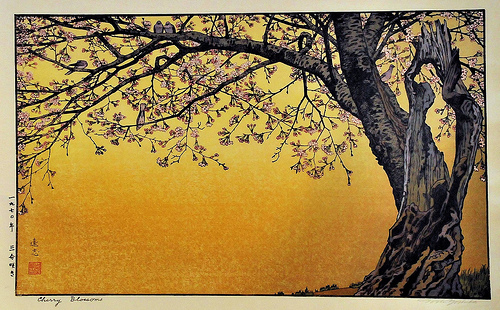 Ukiyo-e Toshi Yoshida Sanbu Zaki Cherry Blossoms In Japan cherry blossoms symbolize clouds due to their nature of blooming en masse, besides being an enduring metaphor for the ephemeral nature of life, an aspect of Japanese cultural tradition that is often associated with Buddhistic influence.
 cherry blossoms like clouds The transience of the blossoms, the extreme beauty and quick death, has often been associated with mortality; for this reason, cherry blossoms are richly symbolic, and have been utilized often in Japanese art and film, as well as at musical performances for ambient effect.
from wikipedia.org
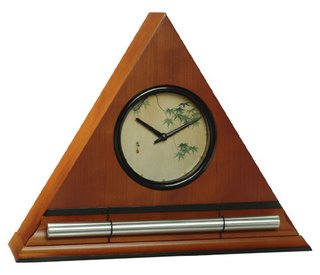 Zen Clocks by Now & Zen, Boulder, CO
Now & Zen Headquarters
1638 Pearl Street
Boulder, CO 80302
(800) 779-6383
Posted in Chime Alarm Clocks, Japanese Inspired Zen Clocks, Meditation Timers, Now & Zen Alarm Clocks, Progressive Awakening
...the art of the ‘tea ceremony’ inspired by Japan continued…
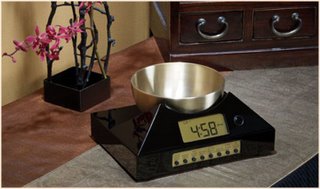 Zen Timepiece, a timer for the 'way of tea' ceremony In that the Japanese tea ceremony is conventionally conducted sitting on tatami, seiza is integral to it. Unless it is the ryūrei style of tea ceremony, which employs chairs and tables, both the host and guests sit in seiza throughout.
To sit seiza-style, one first kneels on the floor, folding one’s legs underneath one’s thighs, while resting the buttocks on the heels. The ankles are turned outward as the tops of the feet are lowered so that, in a slight “V” shape, the tops of the feet are flat on the floor and big toes are overlapped, and the buttocks are finally lowered all the way down. Depending on the circumstances, the hands are folded modestly in the lap, or are placed palm down on the upper thighs with the fingers close together, or are placed on the floor next to the hips, with the knuckles rounded and touching the floor. The back is kept straight, though not unnaturally stiff. Traditionally, women sit with the knees together while men separate them slightly.
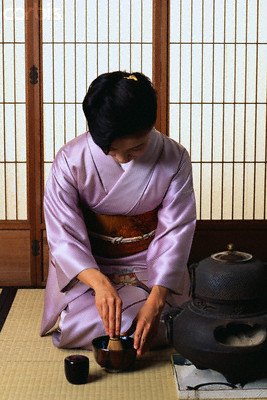 Japanese woman performing tea ceremony in seiza sitting position Stepping into and out of seiza is mindfully performed. There are codified traditional methods of entering and exiting the sitting position depending on occasion and type of clothing worn.
All the bows (there are three basic variations, differing mainly in depth of bow and position of the hands) performed during tea ceremony originate in the seiza position.
from wikipedia.org
Posted in Japanese Inspired Zen Clocks, Meditation Timers, Meditation Tools, Now & Zen Alarm Clocks, Progressive Awakening
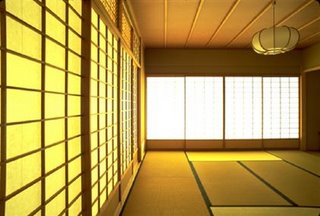 tatami-floored tea room for tea ceremony ...the art of ‘way of tea’ inspired by Japan…
By the 16th century, tea drinking had spread to all levels of society in Japan.
Almost any place where implements for the making and serving of the tea can be set out, and where the host can make the tea in the presence of the seated guest(s), can be used as a venue for tea.
A tatami-floored room with adjacent mizuya space for the host to conduct preparations of the various items to be used is required for a full chaji.
Many schools of Japanese tea ceremony have evolved through the long history of chadō and are active today.
from wikipedia.org
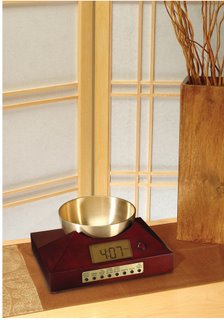 Zen Timepiece, a chime alarm clock and timer in cherry finish Now & Zen Headquarters
1638 Pearl Street
Boulder, CO 80302
(800) 779-6383
Posted in Chime Alarm Clocks, Japanese Inspired Zen Clocks, Meditation Tools, Natural Awakening, Now & Zen Alarm Clocks, Tea Ceremony, wabi-sabi, Zen Timepiece by Now & Zen, Zen Timers
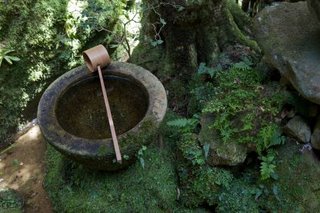 wabi-sabi tea ceremony The tea ceremony in Japan developed as a “transformative practice”, and began to evolve its own aesthetic, in particular that of wabi. Wabi, meaning quiet or sober refinement, or subdued taste, “is characterized by humility, restraint, simplicity, naturalism, profundity, imperfection, and asymmetry [emphasizing] simple, unadorned objects and architectural space, and [celebrating] the mellow beauty that time and care impart to materials.” (see now & zen blogs on wabi-sabi, March 2010.)
wikipedia.org
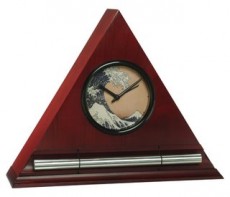 Zen Alarm Clock, Ukiyo-e Hokusai Wave Dial Face Now & Zen
1638 Pearl Street
Boulder, CO 80302
(800) 779-6383
Posted in Japanese Inspired Zen Clocks, Tea Ceremony, Zen Timers
 ukiyo-e woodblock print: traditional tea ceremony in kimono by master Utagawa Toyokuni Seasonality and the changing of the seasons are important in the tea ceremony from Japan. Traditionally the year is divided by tea practitioners into two main seasons: the sunken hearth season, constituting the colder months (traditionally November to April), and the brazier season, constituting the warmer months (traditionally May to October). For each season, there are variations in the temae performed and utensils and other equipment used.
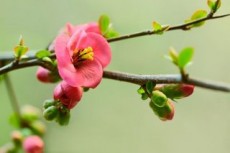 cherry blossoms wikipedia.org
Now & Zen Headquarter Store
1638 Pearl Street
Boulder, CO 80302
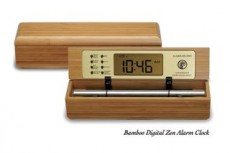 Bamboo Zen Clock and Timers
Posted in Japanese Inspired Zen Clocks, Now & Zen Alarm Clocks, Tea Ceremony, wabi-sabi, Zen Timers
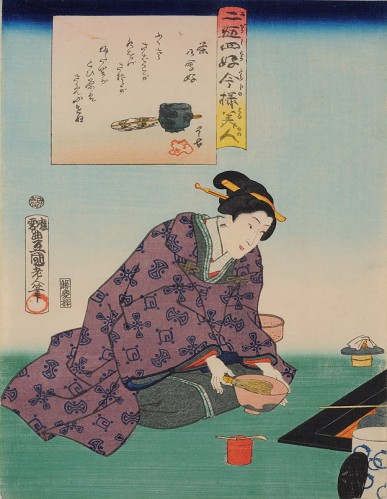 Utagawa Kunisada (1786-1865), a woman performing the tea ceremony The Japanese tea ceremony, also called the Way of Tea, is a Japanese cultural activity involving the ceremonial preparation and presentation of matcha, powdered green tea.
Many of the movements and components of tea ceremony from Japan, evolved from the wearing of kimono and, although it is not uncommon for students nowadays to wear western clothes for practice, most will practice in kimono at least some of the time, for this is essential to learn the prescribed motions properly.
wikipedia.org
 Zen Timer for tea ceremony, black laquer "E" tone digital version Now & Zen
1638 Pearl Street
Boulder, CO 80302
(800) 779-6383
Posted in Chime Alarm Clocks, Japanese Inspired Zen Clocks, Meditation Timers, Now & Zen Alarm Clocks, Tea Ceremony
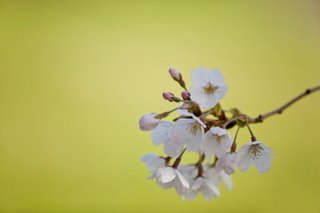 wabi sabi, the beauty of imperfection …a continuing admiration of wabi-sabi from Japan…
Wabi-sabi represents a comprehensive Japanese world view or aesthetic centered on the acceptance of transience.
Characteristics of the wabi-sabi aesthetic include asymmetry, asperity, simplicity, modesty, intimacy, and the suggestion of natural processes.
from wikipedia.org
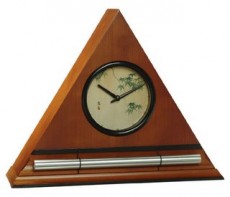 Zen Alarm Clock in Honey Finish Now & Zen Headquarter Store
1638 Pearl Street
Boulder, CO 80302
(800) 779-6383
Posted in Japanese Inspired Zen Clocks
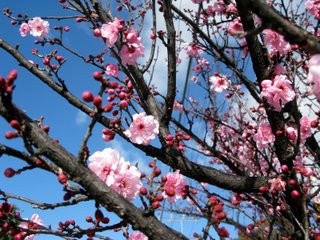 wabi-sabi: the beauty of imperfection …a continuing appreciation of wabi-sabi from Japanese culture…
The words wabi and sabi do not translate easily. Wabi connotes rustic simplicity, freshness or quietness, and can be applied to both natural and human-made objects, or understated elegance. It can also refer to quirks and anomalies arising from the process of construction, which add uniqueness and elegance to the object. Sabi is beauty or serenity that comes with age, when the life of the object and its impermanence are evidenced in its patina and wear, or in any visible repairs.
from wikipedia.org
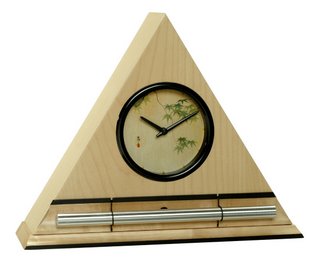 - Zen Alarm Clock in Maple Finish
Now & Zen Headquarters
1638 Pearl Street
Boulder, CO 80302
(800) 779-6383
Posted in Japanese Inspired Zen Clocks
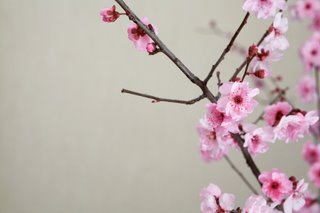 nothing lasts, nothing is finished, and nothing is perfect wabi-sabi, the art of imperfection
Wabi-sabi is the most conspicuous and characteristic feature of traditional Japanese beauty and it “occupies roughly the same position in the Japanese pantheon of aesthetic values as do the Greek ideals of beauty and perfection in the West. “
“If an object or expression can bring about, within us, a sense of serene melancholy and a spiritual longing, then that object could be said to be wabi-sabi.”
The words wabi and sabi do not translate easily. Wabi originally referred to the loneliness of living in nature, remote from society; sabi meant “chill”, “lean” or “withered”. Around the 14th century these meanings began to change, taking on more positive connotations. Wabi now connotes rustic simplicity, freshness or quietness, and can be applied to both natural and human-made objects, or understated elegance.
“It (wabi-sabi) nurtures all that is authentic by acknowledging three simple realities: nothing lasts, nothing is finished, and nothing is perfect.”
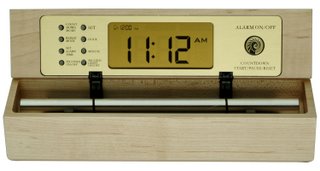 - Maple Zen Clock
from wikipedia.org
Now & Zen Headquarters
1638 Pearl Street
Boulder, CO 80302
(800) 779-6383
Posted in Japanese Inspired Zen Clocks, wabi-sabi
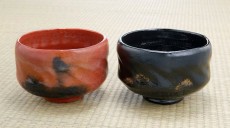 Wabi-Sabi red and black glazed Raku tea cup set ….more musings on wabi-sabi
In one sense wabi sabi is a training where the student of wabi sabi learns to find the most simple objects interesting, fascinating and beautiful. Fading autumn leaves would be an example.
Wabi sabi can change our perception of our world to the extent that a chip or crack in a vase makes it more interesting and give the object greater meditative value. Similarly materials that age such as bare wood, paper and fabric become more interesting as they exhibit changes that can be observed over time.
The wabi and sabi concepts are religious in origin, but actual usage of the words in Japanese is often quite casual.
from Wikipedia
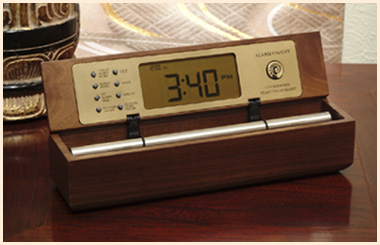 Digital Zen Alarm Clock
Now & Zen
1638 Pearl Street
Boulder, CO 80302
(800) 779-6383
Posted in Japanese Inspired Zen Clocks, Meditation Timers, Meditation Tools, Natural Awakening, Now & Zen Alarm Clocks, Yoga Timers by Now & Zen
|
|
|
|